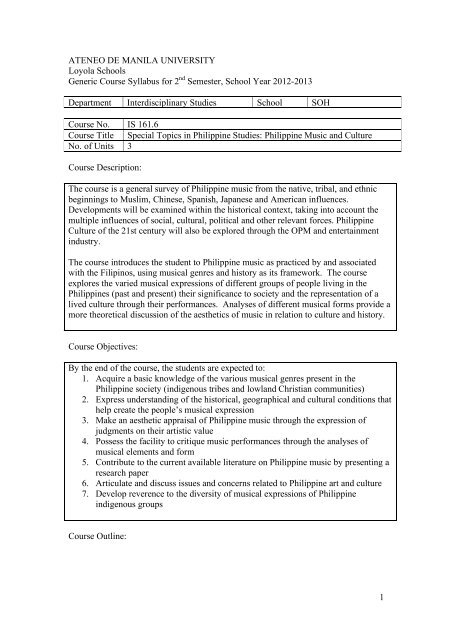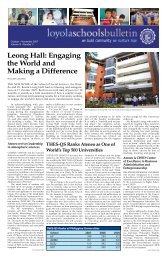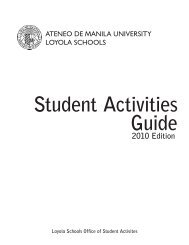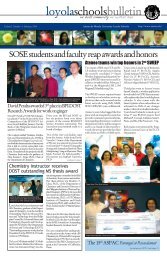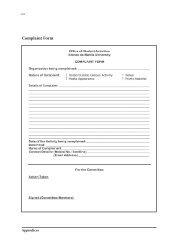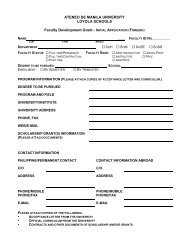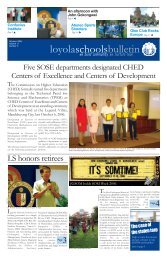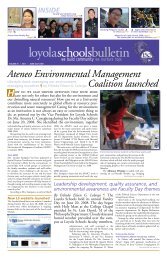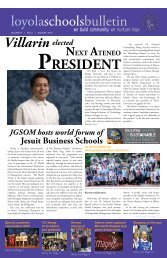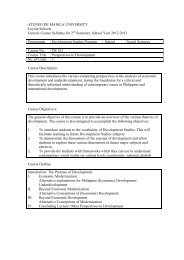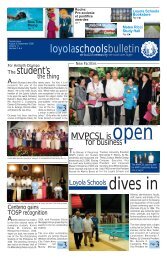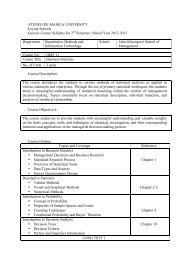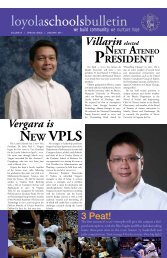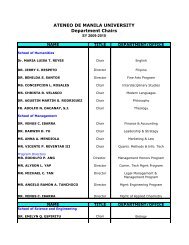IS Generic Course Syllabi II Sem 12-13 - Ateneo de Manila University
IS Generic Course Syllabi II Sem 12-13 - Ateneo de Manila University
IS Generic Course Syllabi II Sem 12-13 - Ateneo de Manila University
- No tags were found...
Create successful ePaper yourself
Turn your PDF publications into a flip-book with our unique Google optimized e-Paper software.
ATENEO DE MANILA UNIVERSITYLoyola Schools<strong>Generic</strong> <strong>Course</strong> Syllabus for 2 nd <strong>Sem</strong>ester, School Year 20<strong>12</strong>-20<strong>13</strong>Department Interdisciplinary Studies School SOH<strong>Course</strong> No. <strong>IS</strong> 161.6<strong>Course</strong> Title Special Topics in Philippine Studies: Philippine Music and CultureNo. of Units 3<strong>Course</strong> Description:The course is a general survey of Philippine music from the native, tribal, and ethnicbeginnings to Muslim, Chinese, Spanish, Japanese and American influences.Developments will be examined within the historical context, taking into account themultiple influences of social, cultural, political and other relevant forces. PhilippineCulture of the 21st century will also be explored through the OPM and entertainmentindustry.The course introduces the stu<strong>de</strong>nt to Philippine music as practiced by and associatedwith the Filipinos, using musical genres and history as its framework. The courseexplores the varied musical expressions of different groups of people living in thePhilippines (past and present) their significance to society and the representation of alived culture through their performances. Analyses of different musical forms provi<strong>de</strong> amore theoretical discussion of the aesthetics of music in relation to culture and history.<strong>Course</strong> Objectives:By the end of the course, the stu<strong>de</strong>nts are expected to:1. Acquire a basic knowledge of the various musical genres present in thePhilippine society (indigenous tribes and lowland Christian communities)2. Express un<strong>de</strong>rstanding of the historical, geographical and cultural conditions thathelp create the people’s musical expression3. Make an aesthetic appraisal of Philippine music through the expression ofjudgments on their artistic value4. Possess the facility to critique music performances through the analyses ofmusical elements and form5. Contribute to the current available literature on Philippine music by presenting aresearch paper6. Articulate and discuss issues and concerns related to Philippine art and culture7. Develop reverence to the diversity of musical expressions of Philippineindigenous groups<strong>Course</strong> Outline:1
Weeks 1-6Weeks 7-11Music of the Northern and SouthernTribesTribes, instruments, vocal music, musical practices, musical concepts/theories, practical/ hands-on music makingReadings:Hila, Antonio C. Musika: An Essay on Philippine Ethnic Music.Maceda, Jose. Upland Peoples of the Philippines, from The GarlandEncyclopedia of World Music, Volume 4. New York and London:Garland Publishing, Inc., 1998.Kalanduyan, Danongan. Maguindanaon Kulintang Music. (From AsianMusic Journal)Cadar, Usopay. The Role of Kolintang Music in Maranao Society (FromAsian Music Journal)Special Activities:Playing of Cordillera instruments (with practical examination)Gui<strong>de</strong>d and individual listening to recordingsFilm showing on Philippine ethnic musicUnit Tests 1& 2Lowland Christian Filipinos and Art Music in the PhilippinesHistory (1521-1898 - Spanish period; 1898-1941 – American period;1941-1945 – Japanese Occupation; 1945-present – Philippine Republic);Music instruction from the different religious groups and the Spanishregiments; musical life of the 1800s, first half of the 20 th century, afterWW<strong>II</strong> and contemporary musical setting in the PhilippinesReadings:Dioquino, Corazon. Lowland Christian Philippines (From the GarlandEncyclopedia)Santos, Ramon. Art Music in the 20 th Century (From the GarlandEncyclopedia)Hila, Antonio. Music in History, History in Music.Unit Test 3Weeks <strong>12</strong>- 17 Special topics related to Philippine MusicNational Artists in Music, Government Institutions supporting musicand musical productions (CCP, NCCA, NAMCYA, etc.), Resi<strong>de</strong>ntperforming groups of the CCP, Philippine Choral Music, Kundiman asan art song, Filipino composers and their works (Symphonies,Concertos, Piano works, etc.), Philippine Theater and Opera, PhilippineDances, Brass Band Tradition, Popular Music, Original Pilipino Music,Current trends in the Philippine music scene, Music Institutions andschools in the Philippines, Folk songs, Liturgical Music.Research and reportingWeek 18Final Examination2
ATENEO DE MANILA UNIVERSITYLoyola Schools<strong>Generic</strong> <strong>Course</strong> Syllabus for 2 nd <strong>Sem</strong>ester, School Year 20<strong>12</strong>-20<strong>13</strong>Department Interdisciplinary Studies School SOH<strong>Course</strong> No. I.S. 143.4 / HUM 142<strong>Course</strong> Title Introduction to Interdisciplinary ApproachesNo. of Units 3<strong>Course</strong> Description:An Introduction to the elements and principles of aesthetic experience in the visualarts, performing arts, and literature, as well as an examination of aesthetic norms andstandards.<strong>Course</strong> Objectives:To study the different art forms in representative works for stu<strong>de</strong>nts to see commonformal elements that make the arts both uniquely different and yet similar.<strong>Course</strong> Outline:1 ST Week……………Aesthetics: Basis for an Interdisciplinary Approach2 ND -3 RD Week……….Architecture and Society Field Work: The UP Chapel4 TH -5 TH Week………..Industrial Design and Technology Project: AnInterdisciplinary Approach to a Study of Car Design6 TH -7 TH Week…………Folk and Popular Arts and Culture Project: AnInterdisciplinary Approach to a Study of the Jeepney Art8 TH, 9 TH Week ……......Film and a Changing World Project: A Study of Three FilmVersions Shakespeare's Romeo and Juliet10 TH- 11 Week…………Politics and Art Project: A Study of Monuments in Metro<strong>Manila</strong><strong>12</strong> TH -<strong>13</strong> TH Week ……….Interdisciplinary Approach to Literature Project: A Study ofGreek Tragedy<strong>13</strong> TH -15 TH Week………..Aesthetics in Television Commercials: A Study of BeerCommercials16 TH- 17 TH Week………..Filipino Aesthetics18 TH Week……………..Synthesis3
ATENEO DE MANILA UNIVERSITYLoyola Schools<strong>Generic</strong> <strong>Course</strong> Syllabus for 2 nd <strong>Sem</strong>ester, School Year 20<strong>12</strong>-20<strong>13</strong>Department Interdisciplinary Studies School SOH<strong>Course</strong> No. I.S./Hum 152<strong>Course</strong> Title Senior <strong>Sem</strong>inar <strong>II</strong>No. of Units 3<strong>Course</strong> Description:In this course, stu<strong>de</strong>nts complete, <strong>de</strong>fend, and submit the senior seminar paper.<strong>Course</strong> Outline:Timeframe11 November Orientation to the course18 November – 6 December Submission of chapters and consultations9 December Submission of first draft of the complete paper16 December Consultations6 January 2003 Consultations<strong>13</strong> January Submission of revised paper20 January – 21 February Defense period24 February Submission of final paper4
ATENEO DE MANILA UNIVERSITYLoyola Schools<strong>Generic</strong> <strong>Course</strong> Syllabus for 2 nd <strong>Sem</strong>ester, School Year 20<strong>12</strong>-20<strong>13</strong>Department Interdisciplinary Studies School SOH<strong>Course</strong> No. I.S./Hum 147<strong>Course</strong> Title Great Books <strong>II</strong>INo. of Units 3<strong>Course</strong> Description:The last of the Great Books series, the course explores the traditional concerns ofmo<strong>de</strong>rn man (alienation, fragmentation) and recent <strong>de</strong>bates on race, gen<strong>de</strong>r, class, andthe very existence of the canon of “great books.” Selections from 20 th century worldliterature are read and discussed.<strong>Course</strong> Objectives:At the end of the semester, stu<strong>de</strong>nts should be able to analyze and comment criticallyand intelligently on the assigned readings.<strong>Course</strong> Outline and Readings:Week 1Week 2Week 3Week 4Week 5Week 6Week 7Week 8Week 9Week 10Week 11Week <strong>12</strong>Week <strong>13</strong>Week 14Week 15Week 16Week 17Orientation to the courseErnest Hemingway, A Farewell to ArmsAnton Chekhov, The Cherry OrchardJames Joyce, DublinersT.S. Eliot, The Wasteland and other poemspaper 1 dueHermann Hesse, SiddharthaAlbert Camus, The Outsi<strong>de</strong>r (The Stranger)Samuel Beckett, Waiting for GodotChinua Achebe, Things Fall ApartGabriel Garcia Marquez, Collected Storiespaper 2 dueKarl Marx, The Communist ManifestoSigmund Freud, The Interpretation of DreamsCharles Darwin, The Origin of SpeciesJohn Stuart Mill, On Libertypaper 3 due5
ATENEO DE MANILA UNIVERSITYLoyola Schools<strong>Generic</strong> <strong>Course</strong> Syllabus for 2 nd <strong>Sem</strong>ester, School Year 20<strong>12</strong>-20<strong>13</strong>Department Interdisciplinary Studies School SOH<strong>Course</strong> No. I.S./Hum 146<strong>Course</strong> Title Great Books <strong>II</strong>No. of Units 3<strong>Course</strong> Description:The second part of the Great Books series provi<strong>de</strong>s insights into the human realitythrough the reading of books that have endured the test of time. Selections inclu<strong>de</strong> theworks of Dante, Cervantes, Shakespeare, Goethe, Augustine, and Machiavelli, amongothers.<strong>Course</strong> Objectives:At the end of the semester, stu<strong>de</strong>nts should be able to analyze and comment criticallyand intelligently on the assigned readings.<strong>Course</strong> Outline and Readings:1. General Introduction2. The Anglo-Saxon heroic epic (Beowulf)3. Medieval allegory (Dante, Inferno)4. Courtly Love (Andreas Capellanus, The Art of Courtly Love and Chretien <strong>de</strong>Troyes, The Knight of the Cart)5. The novel (Miguel <strong>de</strong> Cervantes, Don Quixote)6. Renaissance drama (William Shakespeare, selected plays)7. Political theory (Niccolo Machiavelli, The Prince and Thomas Moore, Utopia)8. Enlightenment satire (Voltaire, Candi<strong>de</strong>)9. Romantic drama (Goethe, Faust)6
ATENEO DE MANILA UNIVERSITYLoyola Schools<strong>Generic</strong> <strong>Course</strong> Syllabus for 2 nd <strong>Sem</strong>ester, School Year 20<strong>12</strong>-20<strong>13</strong>Department Interdisciplinary Studies School SOH<strong>Course</strong> No. I.S./Hum 145<strong>Course</strong> Title Great Books INo. of Units 3<strong>Course</strong> Description:A course on the Epics, the Scriptures, the Greek dramas, the Philosophers, and otherenduring masterpieces of the ancient world. The course discusses and explores the i<strong>de</strong>asembodied in these texts.<strong>Course</strong> Objectives:At the end of the semester, stu<strong>de</strong>nts should be able to analyze and comment criticallyand intelligently on the assigned readings.<strong>Course</strong> Outline and Readings:1. General Introduction2. The epics of Homer (Iliad, Odyssey)3. The tragedies of Aeschylus, Sophocles, and Euripi<strong>de</strong>s (Agamemnon, Oedipus Rex,Me<strong>de</strong>a)4. The philosophies of Plato and Aristotle (Symposium, Nicomachean Ethics)5. Selections from the Analects and Tao te ching6. The Bible7. Additional classics as time permits (other works by authors listed or selections fromAristophanes and Virgil)7
ATENEO DE MANILA UNIVERSITYLoyola Schools<strong>Generic</strong> <strong>Course</strong> Syllabus for 2 nd <strong>Sem</strong>ester, School Year 20<strong>12</strong>-20<strong>13</strong>Department Interdisciplinary Studies School SOH<strong>Course</strong> No. <strong>IS</strong> 164.1<strong>Course</strong> Title Introduction to Sports BusinessNo. of Units 3<strong>Course</strong> Description:This introductory course is <strong>de</strong>signed primarily for stu<strong>de</strong>nts who want to combine theirpassion for sports with business knowledge. Its major thrust is towards exposing thevarious components of the sports business to stu<strong>de</strong>nts who are consi<strong>de</strong>ring a career insports marketing, event management, and marketing sports or sports-related properties.The course will provi<strong>de</strong> stu<strong>de</strong>nts with the opportunity to apply marketing principles tothe area of sports business. In addition, it will inclu<strong>de</strong> comprehensive group projects andreadingrequirements.8
ATENEO DE MANILA UNIVERSITYLoyola Schools<strong>Generic</strong> <strong>Course</strong> Syllabus for 2 nd <strong>Sem</strong>ester, School Year 20<strong>12</strong>-20<strong>13</strong>Department Interdisciplinary Studies School SOH<strong>Course</strong> No. <strong>IS</strong> 163.3<strong>Course</strong> Title Cultural Studies of Technology (Hypermedia, the World Wi<strong>de</strong> Web, andContemporary Critical Theory)No. of Units 3<strong>Course</strong> Description:This is an introductory course on the cultural studies of technology from a globalperspective. It can be used as an elective by social science, humanities, orinterdisciplinary studies major. In this one-semester course, we shall explore therhizomatics of technology in the history of the present and highlight the multi-linear andnon-narrative form of the World Wi<strong>de</strong> Web and other hypermedia technologies. Issuessuch as the changing parameters of reading and literacy, the impact of an emergingnetwork culture on the contemporary postcolonial, and many more besi<strong>de</strong>s are pursuedthrough extensive readings and the experiencing of various hypermedia tools.Prospective stu<strong>de</strong>nts will explore hypertext non/fiction and other documents drawn fromthe World Wi<strong>de</strong> Web.<strong>Course</strong> Objectives:By the end of the semester, the stu<strong>de</strong>nts should be able to:1. Appreciate various hypermedia technologiesof recent times as subjects of seriousinquiry and further cultural study2. Have a wi<strong>de</strong>r and <strong>de</strong>eper un<strong>de</strong>rstanding of the diverse and profound interactionsthat occur between culture and the rapidly changing technology of the present.3. Competently utilize critical theory in consi<strong>de</strong>ring their own experiences withhypermedia toolsReferences (optional):Bell, David. An Introduction to Cybercultures. New York, N.Y.: Routledge, 2001.Durham, Meenakshi Gigi and Douglas M. Kellner. Media and Cultural Studies:Keyworks. Mal<strong>de</strong>n, MA: Blackwell, 2006.Ebert, Roger. "Roger Ebert's Journal." 16 April 2010. Chicago Sun Times. 1 May 20<strong>12</strong>.Everett, Anna. Digital Diaspora: A Race for Cyberspace. Albany: SUNY Press, 2009.Featherstone, Mike and Roger Burrows. Cyberspace, Cyberbodies, Cyberpunk: Culturesof Technological Embodiment. London: Sage Publications, 1996.Lindlof, Thomas R. and Bryan C. Taylor. Qualitative Communication ResearchMethods. Thousand Oaks, California: Sage Publications, 2002.9
Miller, Vincent. Un<strong>de</strong>rstanding Digital Culture. Los Angeles: Sage, 2011.Moriarty, Brian. "An Apology for Roger Ebert." 04 March 2011. Brian Moriarty |Lectures and Presentations. <strong>12</strong> March 2011.Paul, Christiane. Digital Art. London: Thames & Hudson, 2008.Siemens, Ray and Susan Schreibman. A Companion to Digital Literary Studies. Mal<strong>de</strong>n,MA, USA: Blackwell Pub., 2007.TEDxTalks. YouTube - TEDxUSC - Kellee Santiago - 3/23/09. 17 August 2009. 1 May20<strong>12</strong> .10
ATENEO DE MANILA UNIVERSITYLoyola Schools<strong>Generic</strong> <strong>Course</strong> Syllabus for 2 nd <strong>Sem</strong>ester, School Year 20<strong>12</strong>-20<strong>13</strong>Department Interdisciplinary Studies School SOH<strong>Course</strong> No. <strong>IS</strong> 163.15<strong>Course</strong> Title Muslim-Christian Dialogue and Cooperation for Nation BuildingNo. of Units 3<strong>Course</strong> Description:Inherent in both Islamic spirituality and Christian spirituality are values and initiativesthat can help (1) push for good governance, (2) establish peace and or<strong>de</strong>r in Mindanao,and (3) protect our environment—three major components of nation-building. BothIslam and Christianity are compatible with <strong>de</strong>mocracy, and both value transparency andtolerance as key ingredients to good governance. The course provi<strong>de</strong>s a framework ofdialogue within which these shared i<strong>de</strong>als and values can be applied in nation-buildingprojects.<strong>Course</strong> Objectives:At the end of the course, the stu<strong>de</strong>nts should be able to (1) <strong>de</strong>velop an attitu<strong>de</strong> open todialogue with Islam and Christianity. They should be able to (2) i<strong>de</strong>ntify flawe<strong>de</strong>lements in the practice of Islam and Christianity that are hindrances to national<strong>de</strong>velopment. Lastly, the stu<strong>de</strong>nts should be able to (3) i<strong>de</strong>ntify points of convergencebetween these two religions in regard to nation-building. The stu<strong>de</strong>nts will learn thatboth Islam and Christianity share in the work of alleviating poverty and protecting theenvironment.The objectives can be achieved through class discussions based on the assignedreadings, their conclusions validated through oral exams, and their leanings <strong>de</strong>epened bywriting a research paper at the end of the course.References (optional):Abdul-Matin, Ibrahim. Green Deen: What Islam Teaches about Protecting thePlanet. Berrett-Koehler Publishers, 2010.Ayoub, Mahmoud. A Muslim View of Christianity. Orbis Books, 2007.El Fadl, Khaled Abou. The Great Theft: Wrestling Islam from theExtremists. San Francisco: Harper Collins, 2007.Gulen, Fethullah. Essentials of The Islamic Faith. New York: TughraBooks, 2011.Hashimi, Na<strong>de</strong>r. Islam, Secularism, and Liberal Democracy: Toward aDemocratic Theory for Muslim Societies. Oxford <strong>University</strong> Press, 2009.Oliveros, Renato. “Maryam Eco-Spirituality.”http://inonegod.wordpress.com/20<strong>12</strong>/01/30/a-maryam-eco-spirituality/11
ATENEO DE MANILA UNIVERSITYLoyola Schools<strong>Generic</strong> <strong>Course</strong> Syllabus for 2 nd <strong>Sem</strong>ester, School Year 20<strong>12</strong>-20<strong>13</strong>Department Interdisciplinary Studies School SOH<strong>Course</strong> No. <strong>IS</strong> <strong>13</strong>4.6<strong>Course</strong> Title Introduction to Interdisciplinary ApproachesNo. of Units 3<strong>Course</strong> Description:A study of the significance of interdisciplinary as a conceptual tool in analyzing issuesand problems. It equips stu<strong>de</strong>nts with some knowledge of the different methodsi<strong>de</strong>ntified with the various disciplines which will prepare them for thesis writing.<strong>Course</strong> Objectives:A. To make the stu<strong>de</strong>nts aware of the need for and significance of interdisciplinarity as aconceptual tool in analyzing issues and problemsB. To equip the stu<strong>de</strong>nts with some knowledge of the different methods i<strong>de</strong>ntified withthe various disciplinesC. To equip the stu<strong>de</strong>nts with some skills in research work and research writing in or<strong>de</strong>rto prepare them for writing their senior seminar paper (thesis)<strong>Course</strong> Outline:D<strong>IS</strong>CUSSION: THE MEANING OF INTERD<strong>IS</strong>CIPLINARITY(1) Reyes, “The Interdisciplinary Studies Approach: A Definition”(2) Kolvenbach, “On the Interdisciplinary Approach”(3) EITHER: Reyes, “The Interdisciplinary Studies Program” OR Davidson andGoldberg,“A Manifesto for the Humanities…”(4) Newsweek articles on the April 2007 Virginia Tech massacreLECTURE: RESEARCH METHODS AND RESEARCH WRITINGSample of an outstanding Junior <strong>Sem</strong>inar PaperD<strong>IS</strong>CUSSION: Interdisciplinary analysis of a PHENOMENON: The call center industryin the Phil.and the welfare of call center workers Regina Hechanova-Alampay entitled1-800 Philippines: Un<strong>de</strong>rstanding and Managing the Philippine Call Center WorkerSUBM<strong>IS</strong>SION: 2 copies of the RESEARCH TOPIC PROPOSALTo be submitted to the <strong>IS</strong> Dept. by 5 p.m.<strong>13</strong>
D<strong>IS</strong>CUSSION: Interdisciplinary analysis of an EVENT: The EDSA <strong>II</strong> (Dos) PeoplePower Revolution(1) Jose Abueva, “A Crisis of Political Lea<strong>de</strong>rship…”(2) Ma. Cynthia Rose Banzon Bautista, “People Power 2: `The Revenge of the Elite onthe Masses’?”D<strong>IS</strong>CUSSION: Interdisciplinary analysis of a SOCIAL <strong>IS</strong>SUE:The impact of international labor migration on Phil.Society/Families(1) Filomeno V. Aguilar, Jr., ed., Filipinos in Global Migration (2002)(2) Rhacel Salazar Parreñas, Children of Global Migration (2005)(3) Lour<strong>de</strong>s Carandang et al., Nawala ang Ilaw ng Tahanan (2007)(4) Filomeno V. Aguilar, Maalwang Buhay: Family, Overseas Migration, and Culturesof Relatedness in Barangay Paraiso (2009)FILM VIEWING (One Flew Over the Cuckoo’s Nest, directed byMilos Forman, based on the novel by Ken Kesey)D<strong>IS</strong>CUSSION: Interdisciplinary analysis of a CULTURAL ARTIFACT(the film One Flew Over the Cuckoo’s Nest directed by Milos Forman)(1) Alex Thio, “Deviance and Social Control” – which is Chapter 6 of Thio’s book,Sociology: A Brief Introduction; and(2) Jan Bone’s, “The Language of Film” from Un<strong>de</strong>rstanding Film)VIEWING of the film that will be the basis of the midterm examMidterm examinationSUBM<strong>IS</strong>SION: 2 copies of the group’s research proposal (Chptr I)GROUP CONSULTATIONS WITH TEACHER FOR 4 WEEKS, FORRESEARCH PAPER DIRECTION (30 mins. per group)CLASS MEETING: Gui<strong>de</strong>lines for group presentation & group paperSUBM<strong>IS</strong>SION: 2 copies – 1st DRAFT OF COMPLETE PAPERPresentations of Groups 1, 2, and 314
ATENEO DE MANILA UNIVERSITYLoyola Schools<strong>Generic</strong> <strong>Course</strong> Syllabus for 2 nd <strong>Sem</strong>ester, School Year 20<strong>12</strong>-20<strong>13</strong>Department Interdisciplinary Studies School SOH<strong>Course</strong> No. <strong>IS</strong> <strong>13</strong>3.4<strong>Course</strong> Title GENDER, ART AND SOCIETYNo. of Units 3<strong>Course</strong> Description:An introductory course to gen<strong>de</strong>r as it is portrayed in art and society, aiming to lay baregen<strong>de</strong>r issues in the art world in particular in the context of larger gen<strong>de</strong>r constructionsin society.15
ATENEO DE MANILA UNIVERSITYLoyola Schools<strong>Generic</strong> <strong>Course</strong> Syllabus for 2 nd <strong>Sem</strong>ester, School Year 20<strong>12</strong>-20<strong>13</strong>Department Interdisciplinary Studies School SOH<strong>Course</strong> No. <strong>IS</strong> <strong>12</strong>1.8<strong>Course</strong> Title Basic Music Research and CriticismNo. of Units 3<strong>Course</strong> Description:This first course in musicology is an introduction to reliable and recently revised sourcesof music research for writing program notes. It aims to <strong>de</strong>velop good taste in listening tolive and recor<strong>de</strong>d music, an essential ingredient in music criticism.<strong>Course</strong> Outline:First Month (Nov) : Choral/Vocal ConcertChoral Rehearsal/ Voice Lesson ObservationSecond Month (Dec) : Choir and Orchestra ConcertThird Month (Jan):First Listening Test on Choral MusicOrchestra ConcertOrchestra Rehearsal ObservationInstrumental ConcertPiano/Guitar/Violin/Flute Lesson ObservationFourth Month (Feb): Second Listening Test on Orchestral MusicCCP ConcertChamber Music ConcertSolo Piano RecitalFifth Month (March): Music Literature/Concert Reports Magazine (Final Exam Project)References (optional):Diokino, C. (1982). Musicology in the Philippines. Musica ActaPruet, J. 7 Stevens T. (1985). Research Gui<strong>de</strong> to Musicology. Chicago: AmericanLibrarySadie, S (2000) The New Grove Dictionary of Music and Musicology. London:MacmillianLevinson, Jerrold. Performative vs Critical Interpretation16
ATENEO DE MANILA UNIVERSITYLoyola Schools<strong>Generic</strong> <strong>Course</strong> Syllabus for 2 nd <strong>Sem</strong>ester, School Year 20<strong>12</strong>-20<strong>13</strong>Department Interdisciplinary Studies School SOH<strong>Course</strong> No. <strong>IS</strong> <strong>12</strong>1.2<strong>Course</strong> Title Music Appreciation <strong>II</strong>No. of Units 3<strong>Course</strong> Description:Music Appreciation <strong>II</strong> seeks to <strong>de</strong>lve <strong>de</strong>eper into the riches of the symphony orchestraby studying the different instruments, characteristics of a conductor and classical musicof string and wind instruments. Through lectures, discussions, listening and watchingrepresentative and significant musical examples, the stu<strong>de</strong>nt will be aware of the breadthof the totality of music not only as a branch of knowledge but as a means of exploringthe psychomotor and emotional avenues of experience it can offer.<strong>Course</strong> Objectives:Listening to classical music will be an integral part in the pedagogical process ofeducating the individual. The literature will also be studied through watching vi<strong>de</strong>os andattending live concerts.<strong>Course</strong> Outline:I. Review of Elements of Music<strong>II</strong>. The Classical Music Scene and the CCP<strong>II</strong>I. Choral Music vs. Orchestral MusicIV. Voice ClassificationsV. Concert Halls and OrchestrasVI. Different Parts of an orchestraV<strong>II</strong>. Music Lesson/RehearsalsV<strong>II</strong>I. Lecture-RecitalsIX. Listening to Classical MusicX. 98.7 DZFE FM The only classical station in the PhilippinesXI. Similarities of Pop Music to Classical Music17
ATENEO DE MANILA UNIVERSITYLoyola Schools<strong>Generic</strong> <strong>Course</strong> Syllabus for 2 nd <strong>Sem</strong>ester, School Year 20<strong>12</strong>-20<strong>13</strong>Department Interdisciplinary Studies School SOH<strong>Course</strong> No. <strong>IS</strong> <strong>12</strong>1.<strong>13</strong><strong>Course</strong> Title Form Analysis of 18 th Century WorksNo. of Units 3<strong>Course</strong> Description:A course on basic harmonic, form, and motive analysis of small and large works ofHaydn, Mozart, and Beethoven that aims for a more critical listening of works of the18 th Century, a period that called for more structure and balance in music.18
ATENEO DE MANILA UNIVERSITYLoyola Schools<strong>Generic</strong> <strong>Course</strong> Syllabus for 2 nd <strong>Sem</strong>ester, School Year 20<strong>12</strong>-20<strong>13</strong>Department Interdisciplinary Studies School SOH<strong>Course</strong> No. I.S. <strong>12</strong>1.<strong>12</strong><strong>Course</strong> Title Wagner’s Ring: A 21 st Century ApproachNo. of Units 3<strong>Course</strong> Description:This course is a philosophical, sociopolitical and psychological approach to Wagner’s16-hour opera cycle that is based on Nordic mythology. It establishes the relevance ofthe work to present times in every scene of every act, revealing allusions to power play,corruption, retribution and enlightenment.<strong>Course</strong> Outline:I. Wagner’s Life and works (weeks 1 to 3)A. The epitome of RomanticismB. Wagner’s dual personalityC. GesamtkunstwerkD. Wagner’s “Tannhäuser “<strong>II</strong>. An Introduction to Norse Mythology (weeks 4 and 5)A. The godsB. The un<strong>de</strong>rworldC. Men and Women<strong>II</strong>I. Allusion to Tolkien’s “The Lord of the Rings” (week 6)IV. Wagner’s Ring part 1, Das Rheingold (weeks 7 and 8)A. Introduction of charactersB. The forging of the ring of powerC. Sociopolitical implicationsV. Wagner’s Ring part 2, Die Walküre (weeks 9 and 10)A. The Pacts of WotanB. Incest and its implicationsC. The disobedient alteregoVI. Wagner’s Ring part 3, Siegfried (weeks 11 and <strong>12</strong>)A. Wagner and fairy talesB. The ring and the one who does not know fearC. Wotan’s control at an endV<strong>II</strong>. Wagner’s Ring part 4, Götterdämmerung (weeks <strong>13</strong> to 15)A. The ring and the world of menB. Betrayal and retributionC. The end of days of an existing or<strong>de</strong>rD. The twilight of the godsV<strong>II</strong>I. Wagner’s Ring and the 21 st Century (weeks 16 to 17)A. Wagner and Nietzsche19
B. Wagner and SchopenhauerC. The 21 st Century mo<strong>de</strong>lIX. Review and final examinations (week 18)References (optional):Gutman, Robert. 1974. Richard Wagner: the Man, His Mind, and His Music. New York:Harcount, Brace, JovanovichVon Westernhagen, Curt. 1976. The Forging of the Ring: Richard Wagner’scomposition Sketches for the Ring of the Nibelung, trans. Arnold and Mary Whittal.Cambridge <strong>University</strong> PressHatcheson, Ernest. 1940, repr.1972. A musical Gui<strong>de</strong> to Richard Wagner, Ring of theNibelung. New York: Simon and SchusterCarl Dahlhaus. 1979. Richard Wagner’s Music Dramas . Cambridge <strong>University</strong> Press20


